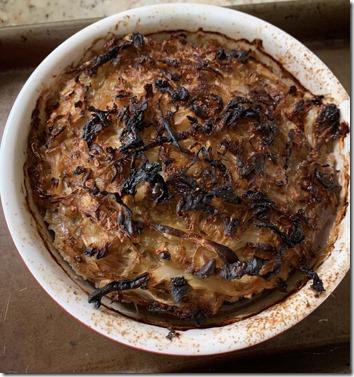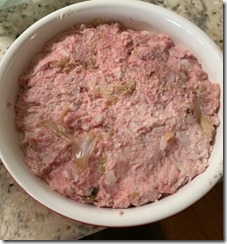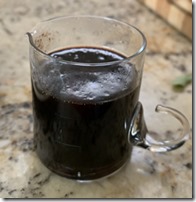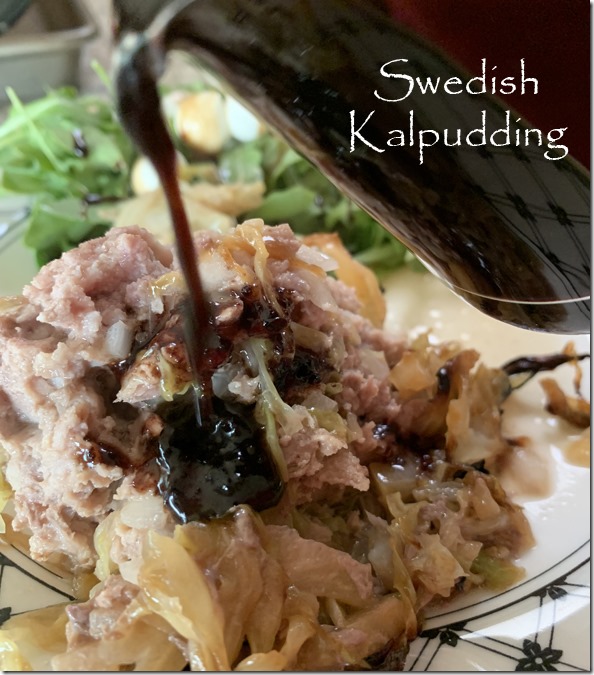This is definitely a savory dish – no pudding as we know it – it’s made with ground beef, ground pork and a lot of cabbage. And then there’s a luscious little drizzle of a sauce that starts with jam or preserves.
Back when my DH (dear hubby Dave) was alive, I cooked a regular dinner every night, unless we went out, or unless we had sufficient leftovers. Now, 6+ years on, my routine is changed significantly. About once I week I fix a traditional dinner with a meat, a veg and maybe a salad. Most evenings now, I make a big green salad with lots of raw veggies in it, with just a speck of some protein (chicken, tuna or eggs). On one of the weekend evenings, I often will fix that more traditional dinner, though. And I think back, fondly, that my DH rarely asked I cook anything in particular – he was happy with whatever I wanted to make, bless him! Occasionally he’d ask if maybe we could barbecue a steak, as he wanted them more frequently than I thought we should. So, obviously, it was left to the cook in the house as to “what shall we have for dinner?” Most frequently my weekend meal is some kind of salmon since it’s so good for us, and I love it. The rest of the time, well, I leave it to my cravings, which are a kind of whimsical thing. I looked it up:
Often, the craving is for foods high in sugar and fats, which can make maintaining a healthful diet difficult. Food cravings are caused by the regions of the brain that are responsible for memory, pleasure, and reward. An imbalance of hormones, such as leptin and serotonin, can also cause food cravings. – from a medical website
In this instance, I don’t think it was that I was craving sugar or fat, so what does that say? What I really wanted was a casserole of some kind. And casseroles usually have carbs. That may have been my desire, yet I try really hard to eat very little carbohydrates. I still do – fruit are, and even some veggies have carbs. It’s the obvious carbs I steer clear from, like potatoes, rice, pasta, beans, bread, corn and peas. Then there’s the sugar carbs – baked goods and desserts.
 Last week I ordered a food delivery from Amazon/Whole Foods. In the order I’d asked for a pound of organic ground pork that I was going to stick in the freezer – probably to make a fall style dish, maybe meatballs in a month or so. I didn’t know what. So when they delivered the food, it was ground beef, not ground pork. Sigh. Then my neighbor made a trip to Trader Joe’s and she found ground pork there. Rather than freezing both chunks of meat, I decided to fix something with them. So you’ll find this recipe, and probably another one shortly with the second half of the meat.
Last week I ordered a food delivery from Amazon/Whole Foods. In the order I’d asked for a pound of organic ground pork that I was going to stick in the freezer – probably to make a fall style dish, maybe meatballs in a month or so. I didn’t know what. So when they delivered the food, it was ground beef, not ground pork. Sigh. Then my neighbor made a trip to Trader Joe’s and she found ground pork there. Rather than freezing both chunks of meat, I decided to fix something with them. So you’ll find this recipe, and probably another one shortly with the second half of the meat.
Looking up recipes in my to-try repertoire, I found a bunch (many meatball oriented) including this dish. It was probably the cabbage that sucked me in. Meatloaf is something I do crave now and then – I’d like nothing better than to have my tried and true favorite one, Sweet and Sour Meatloaf. I wrote up that recipe during the first year I had this blog, 2007. But it contains quite a bit of sugar in the tomato sauced topping, and I try to steer away from those kinds of recipes too, as best I can. Although I could easily substitute monkfruit brown sugar in lieu of the regular stuff and see if I liked it. And use cauliflower mashed potatoes. Maybe I will do that sometime soon as well. Recently I watched a Rachel Ray show and was intrigued with her Sicilian Meatballs. They are calling my name too.
 Meanwhile, back to this dish . . . sorry, that was a whole lot of trivia and not getting to this recipe. The explanation about this dish (I had to look it up online) is that kal in Swedish means cabbage. Someone wrote that if you’d written it as Col-pudding, lots of English/Irish speakers would know cabbage (from colcannon, potatoes and cabbage). The pudding part is so misleading. We think pudding must be sweet, but to the Swedes, I guess it’s not. It has to do with minced meat, and a savory pudding means meatloaf.
Meanwhile, back to this dish . . . sorry, that was a whole lot of trivia and not getting to this recipe. The explanation about this dish (I had to look it up online) is that kal in Swedish means cabbage. Someone wrote that if you’d written it as Col-pudding, lots of English/Irish speakers would know cabbage (from colcannon, potatoes and cabbage). The pudding part is so misleading. We think pudding must be sweet, but to the Swedes, I guess it’s not. It has to do with minced meat, and a savory pudding means meatloaf.
 First you cook the cabbage in butter and a bit of molasses. In Sweden I think they’d use Lyle’s golden syrup, but most westerners would use molasses. I have some Lyle’s, but didn’t want to open the jar, so I used the molasses on the shelf. It doesn’t need much. It helps the cabbage caramelize and gives it a lovely lightly sweetened taste. It took awhile, probably 15-20 minutes, to get the cabbage cooked down and slightly caramelized. The molasses gives it the dark brown color.
First you cook the cabbage in butter and a bit of molasses. In Sweden I think they’d use Lyle’s golden syrup, but most westerners would use molasses. I have some Lyle’s, but didn’t want to open the jar, so I used the molasses on the shelf. It doesn’t need much. It helps the cabbage caramelize and gives it a lovely lightly sweetened taste. It took awhile, probably 15-20 minutes, to get the cabbage cooked down and slightly caramelized. The molasses gives it the dark brown color.
Meanwhile you mix up the meatloaf part with raw onion, salt, pepper, cream and about a third of the cooked cabbage (chopped up finely). No egg in this one. It also had some bread crumbs (I used panko because that’s all I keep on hand). I halved the recipe below and I think I’ll have 3-4 more servings of it, so I used a smaller casserole dish. The meat was spread into the bottom, then the caramelized cabbage is spread on top and leveled a bit. You pour on a little bit of broth on top. It’s been way too hot to turn on my main oven lately, so I baked it in my toaster oven (it has lots of functions, so I used bake at first) and then at the end I turned on the broil function to crisp up the cabbage a little bit. Hence the finished dish (up a few paragraphs) looks slightly burned, but it’s not. Trust me on that!
 While the meat is baking, you mix up the sauce. Lingonberry jam is what’s called for, but I didn’t have any, but I did have blueberry preserves, so they had to suffice. It’s heated up with some butter, red wine vinegar, and then a moderate amount (to taste) of Worcestershire sauce. Someone else who made this recipe substituted raspberry jam for the lingonberries. I know I could buy some if I made a trip to Ikea. It’s about 15 miles away – too far, plus I’m not shopping in stores.
While the meat is baking, you mix up the sauce. Lingonberry jam is what’s called for, but I didn’t have any, but I did have blueberry preserves, so they had to suffice. It’s heated up with some butter, red wine vinegar, and then a moderate amount (to taste) of Worcestershire sauce. Someone else who made this recipe substituted raspberry jam for the lingonberries. I know I could buy some if I made a trip to Ikea. It’s about 15 miles away – too far, plus I’m not shopping in stores.
What’s GOOD: altogether delicious. It definitely satisfied my cravings for a casserole. The meat was very light and tasty, and the cabbage is certainly a great variation on meatloaf. Then the sauce – oh yes, that part is really, really good. Yes, I’d make it again. I think I might make it in a bread pan next time – it might make for easier slicing and serving.
What’s NOT: nothing that I can think of, really. Very easy to make. Very filling.
printer-friendly PDF and MasterCook file (click link to open recipe)
* Exported from MasterCook *
Swedish Kalpudding (Meatloaf with Caramelized Cabbage)
Recipe By: Adapted slightly from The New York Times, Sam Sifton, March 2017
Serving Size: 6
MEATLOAF:
2 tablespoons unsalted butter
1 head cabbage — green, approximately 3 pounds, cored and shredded
3 tablespoons Molasses
Kosher salt and freshly ground pepper — to taste
3/4 pound ground beef
3/4 pound ground pork
1 small yellow onion — peeled and chopped
1 cup heavy cream
4 tablespoons bread crumbs
1/3 cup low-sodium chicken broth — beef or vegetable stock
FOR THE SAUCE:
1/3 cup lingonberry preserves — or blueberry
1 tablespoon red wine vinegar
1 tablespoon unsalted butter — optional
1 teaspoon Worcestershire sauce — or to taste
1. Heat oven to 350. Put a large pan over medium-high heat, and add the butter. When it starts to foam, add the cabbage and molasses, lower the heat to medium and sprinkle with salt. Cook slowly, stirring often, until all the liquid has evaporated and the cabbage is caramelized, approximately 20-25 minutes.
2. While the cabbage is cooking, lightly mix the meats in a large bowl, then add the onion, cream, salt, pepper and breadcrumbs, and mix again to combine.
3. When the cabbage is done, remove about 1/3 of it to a cutting board and chop more finely. Add it to the meat mixture, and mix to combine. Transfer the meat mixture to baking pan or ceramic casserole dish, spreading it out to cover the whole surface evenly. Spread remaining cabbage over the meat, then pour the stock or water over the top and place in the oven, on a sheet tray, to cook for approximately 40 to 45 minutes, or until the cabbage is very, very caramelized, almost dry and crunchy at the edges. Allow it to sit for 10 minutes or so before serving.
4. While the meat and cabbage cooks, make the sauce. Heat lingonberry or blueberry preserves, vinegar and butter in a small pot set over medium heat, then add Worcestershire sauce to taste. Serve alongside the Kalpudding.
Per Serving: 464 Calories; 31g Fat (60.2% calories from fat); 25g Protein; 21g Carbohydrate; 1g Dietary Fiber; 132mg Cholesterol; 145mg Sodium; 16g Total Sugars; 1mcg Vitamin D; 89mg Calcium; 3mg Iron; 627mg Potassium; 256mg Phosphorus.







Leave a Comment!